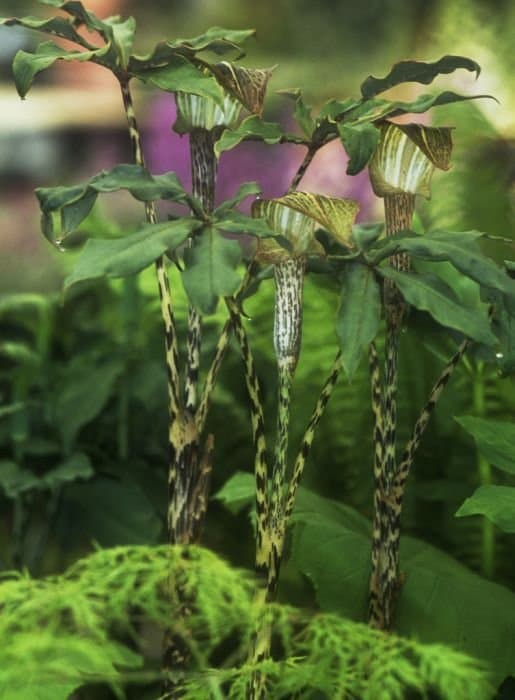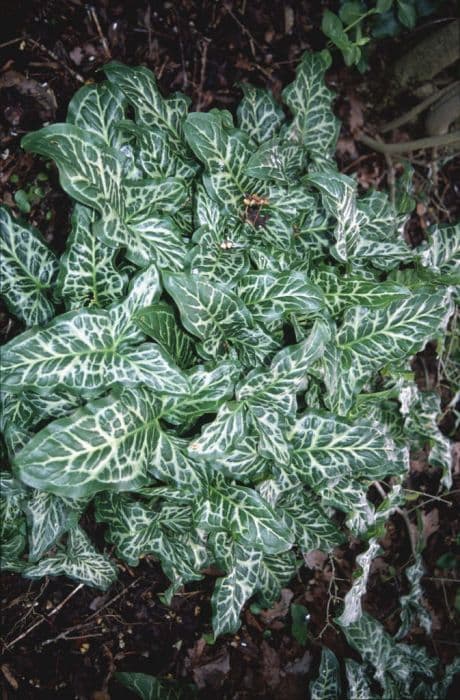Calla Lily 'Captain Solo' Zantedeschia 'Captain Solo' (PBR) (Captain Series)

ABOUT
The plant known as Captain Solo, which is a part of the Captain Series, showcases striking features that make it visually appealing. The most notable characteristic of Captain Solo is its unique and vibrant inflorescence, resembling a large, arrow-shaped flower with a hood-like appearance. This is actually a spathe, which is a brilliantly colored bract that wraps around the central, finger-like spadix. The spathe of Captain Solo appears in a deep and rich shade of maroon or aubergine, presenting a lush, velvety appearance that can add a dramatic touch to gardens or floral displays. Beneath the standout inflorescence, the plant displays large, glossy, and arrow-shaped leaves that convey a sense of lushness and tropical allure. The foliage is typically a deep green, offering a lush backdrop that contrasts beautifully with the bold color of the spathe. The leaves are smooth to the touch and have a waxy texture, with pronounced veins that give them a structured and robust appearance. Overall, Captain Solo exudes an exotic look with its combination of sumptuous coloring and elegant leaf structure, making it an appealing choice for garden enthusiasts looking to enhance their outdoor or indoor spaces with a splash of sophistication and vibrant hues.
About this plant
 Names
NamesFamily
Araceae
Synonyms
Calla Lily, Arum Lily
Common names
Zantedeschia 'Captain Solo' (PBR) (Captain Series).
 Toxicity
ToxicityTo humans
Calla Lily, including the 'Captain Solo' variety, contains insoluble calcium oxalate crystals that can cause irritation and burning of the mouth and digestive tract if ingested. Symptoms of poisoning may include intense burning and irritation of the mouth, tongue, and lips, excessive drooling, difficulty swallowing, and possible swelling of the throat leading to difficulty breathing. Vomiting and diarrhea can also occur. In severe cases, dehydration and a drop in blood pressure might result from fluid loss due to vomiting and diarrhea. Contact with the skin can cause irritation and dermatitis in some individuals.
To pets
Calla Lily, which includes the 'Captain Solo' variety, is toxic to pets such as cats and dogs. The plant contains insoluble calcium oxalate crystals, which, if ingested, can irritate the mouth, tongue, and lips, causing symptoms like excessive drooling, pawing at the mouth, reduced appetite, and difficulty swallowing. In severe cases, ingestion can lead to vomiting, diarrhea, and possibly swelling of the airways, which can cause difficulty breathing. It is important for pet owners to prevent their animals from chewing on or ingesting parts of this plant.
 Characteristics
CharacteristicsLife cycle
Perennials
Foliage type
Evergreen
Color of leaves
Green
Flower color
Red
Height
2 feet (0.61 meters)
Spread
1 foot (0.3 meters)
Plant type
Herb
Hardiness zones
9
Native area
South Africa
Benefits
 General Benefits
General Benefits- Easy to Grow: Thrives in a wide range of conditions with minimal care.
- Attractive Flowers: Features showy flowers that can be a centerpiece in any garden display.
- Long Blooming Period: Provides color and interest in the garden for an extended period.
- Container Gardening: Suitable for pots and containers, allowing for versatile placement around the home or patio.
- Drought Tolerant: Once established, it has good resistance to short periods of drought.
- Low Maintenance: Requires minimal pruning and care, making it suitable for busy gardeners.
- Versatile Landscaping Plant: Can be used in a variety of garden styles, including formal, cottage, and contemporary designs.
 Medical Properties
Medical PropertiesThis plant is not used for medical purposes.
 Air-purifying Qualities
Air-purifying QualitiesThis plant is not specifically known for air purifying qualities.
 Other Uses
Other Uses- Photographic subject: Calla lily's unique form and vibrant coloration make it a stunning subject for professional and amateur photographers alike.
- Art inspiration: The elegant shape and vivid hues of the calla lily have inspired artists to capture its beauty in various mediums, such as painting and sculpture.
- Color dye source: The rich pigments in calla lily petals can potentially be used to create natural dyes for fabrics or art materials.
- Eco-friendly confetti: Dried calla lily petals can serve as a biodegradable alternative to traditional paper or plastic confetti for events.
- Handcrafted paper: Incorporating calla lily fibers or crushed petals into handmade paper can add texture and color to the finished product.
- Fragrance extraction: Although not commonly used for their scent, it's possible to extract a light fragrance from calla lilies for use in homemade perfumes or scented candles.
- Edible garnish: The petals of some calla lily species, when correctly identified and confirmed as non-toxic, can be used to add a decorative touch to gourmet dishes.
- Calligraphy ink reservoir: The hollow stems of the calla lily could theoretically hold ink, providing an innovative and natural tool for calligraphy artists.
- Fashion accessories: The flowers and leaves of the calla lily might be used to create unique, nature-inspired jewelry or fashion accents when preserved in resin.
- Holiday decorations: With their festive appearance, calla lilies can be incorporated into wreaths, centerpieces, or other holiday décor items.
Interesting Facts
 Feng Shui
Feng ShuiThe Calla Lily is used in Feng Shui to attract purity and harmony due to its elegant and sleek shape. It is associated with the metal element and can be placed in the North sector of a space to support career and path in life or in the South West to enhance love and marriage luck.
 Zodiac Sign Compitability
Zodiac Sign CompitabilityThe Calla Lily is not used in astrology practice.
 Plant Symbolism
Plant Symbolism- Elegance - Zantedeschia, commonly known as the calla lily, is often associated with elegance due to its sleek and graceful flowers.
- Beauty - The impeccable form of the calla lily's bloom has made it a symbol of beauty in the plant world.
- Purity - The typical white calla lily is frequently used in weddings and religious ceremonies, symbolizing purity and innocence.
- Rebirth - As a perennial plant that comes back year after year, it is thought to represent the idea of rebirth and resurrection.
- Overcoming challenges - Because calla lilies grow from bulbs that survive underground during unfavorable conditions, they symbolize triumph over hardships.
- Faith and devotion - The flower's trumpet-like shape is reminiscent of a megaphone, representing the idea of broadcasting one's faith and devotion.
- Transcendent beauty - Calla lilies often stand for beauty that goes beyond the physical realm, hinting at a more profound inner quality.
 Water
WaterCalla lilies, including the 'Captain Solo' variety, should be watered thoroughly once the top inch of soil feels dry to the touch, which typically equates to watering once every week during active growth periods. In a container, this might mean using about 1 gallon of water, ensuring excess water can drain freely without leaving the plant in standing water. During dormancy in the cooler months, reduce watering frequency to prevent root rot, providing enough water to prevent the soil from completely drying out. It's crucial to maintain a balance as calla lilies prefer moist but not soggy soil conditions.
 Light
LightCalla lilies, such as 'Captain Solo,' thrive in locations with bright, indirect sunlight. An ideal spot would be a room with eastern or western exposure, receiving morning or late afternoon sun. Direct midday sun can be harsh and might scorch the leaves, so diffused light or slight shading during the brightest part of the day is recommended.
 Temperature
TemperatureZantedeschia 'Captain Solo' prefers temperatures ranging between 60 to 75 degrees Fahrenheit for optimal growth. They can survive minimum temperatures down to about 50 degrees Fahrenheit but will stop growing; maximum temperatures should not exceed 85 degrees Fahrenheit. The ideal conditions for these calla lilies involve avoiding extremes, ensuring they are not exposed to frost or excessively high heat.
 Pruning
PruningPruning 'Captain Solo' calla lilies involves removing spent flowers to encourage more blooming and cutting back foliage only after it has yellowed and died back naturally in the fall. This type of pruning is typically done after the blooming season, around late summer or early autumn. Pruning helps direct the plant's energy towards producing healthy new growth instead of seeding.
 Cleaning
CleaningAs needed
 Soil
SoilThe Calla Lily 'Captain Solo' thrives best in a soil mix that is rich, well-draining, and contains peat, sand, and loam. The ideal pH range for this plant is 5.5 to 6.5 to ensure proper nutrient absorption and support healthy growth.
 Repotting
RepottingCalla Lilies, such as 'Captain Solo', should be repotted every two to three years to refresh the soil and accommodate root growth, ideally in the spring before the growing season begins.
 Humidity & Misting
Humidity & Misting'Captain Solo' Calla Lily prefers moderate to high humidity levels, ranging from 60% to 70%, to mirror its native tropical environment and promote healthy growth and flowering.
 Suitable locations
Suitable locationsIndoor
Place in bright, indirect light with high humidity and well-draining soil.
Outdoor
Plant in partial shade, rich soil, and ensure good drainage and moisture.
Hardiness zone
8-10 USDA
 Life cycle
Life cycleZantedeschia 'Captain Solo', commonly known as Calla Lily 'Captain Solo', begins its life cycle as a rhizome, which is a type of underground stem adapted for storage and regrowth. In spring, the rhizome sprouts and produces long-stemmed, arrow-shaped leaves, followed closely by a distinctive spathaceous inflorescence, which is a colorful bract that surrounds the true flowers. After pollination, typically facilitated by insects, the flowers develop into berries containing the plant's seeds. As the growing season progresses, the plant stores energy in the rhizome for the next season before the above-ground foliage dies back in the fall. During the winter, the plant enters a dormant phase, with the rhizome resting until the conditions are favorable again for the next growing cycle. The rhizome can be divided and replanted to propagate new plants, continuing the life cycle.
 Propogation
PropogationPropogation time
Spring-Summer
Zantedeschia 'Captain Solo', commonly known as Captain Solo Calla Lily, is often propagated by division. This process is ideally carried out in late winter or early spring, just before the growing season begins. To propagate by division, the plant is gently lifted from the ground and the rhizomes, which are the horizontal, underground plant stems, are carefully separated ensuring that each division has at least one growth point or "eye." The divided rhizomes are best planted immediately at a depth of about 3-4 inches (7.6 to 10.16 centimeters) in a mix of well-draining soil and compost, placed in a location with partial to full sunlight and kept moist until they establish. Successful division allows for quick multiplication of plants while maintaining the characteristics of the parent plant.









